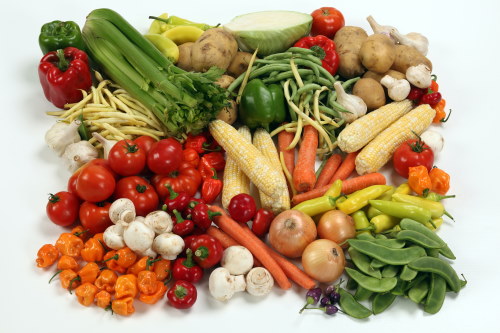If you ask just about any nutritionist or dietitian what to eat, the first thing they’ll likely recommend is more vegetables. Whether looking at The American Heart Association, Harvard Health, the Cleveland Clinic, or the CDC, the common recommendation is five servings (or two to three cups) every day. Sadly, even though vegetables are one of the most important food groups, the vast majority of Americans fall desperately short. A mere 10% of those surveyed consume enough. So, what’s most important is just eating more. Enjoying a greater variety can help, so to get you started, here are eight of the healthiest vegetables to add to your menu.
BREAKING: Boost Your Memory With This Easy Trick
Why Vegetables Matter
Vegetables are nature’s way of providing the essential nutrients our bodies need to grow, repair, and thrive. That includes vitamins and minerals, phytochemicals, and antioxidants. Veggies also offer a good dose of fiber, which can help keep our bodies fuller for longer while also promoting gut health by feeding the good microbiome. A healthy gut, in turn, supports digestion, the immune system, and even brain functioning and mental health.
Another way of putting it is that vegetables are highly nutrient-dense while being calorie-sparse. That means vegetables are a great way of getting the nutrients you need without eating so many calories you gain weight.
Eating more vegetables has been associated with a lower risk of developing numerous diseases, including heart disease, diabetes, and several types of cancer. It’s also been found to improve vision and potentially increase lifespan.
And honestly, researchers haven’t even identified all the potential benefits of eating more vegetables!
Eight of the Healthiest Vegetables to Eat
To get the most proverbial bang for your buck, you can choose from some of the most nutrient-dense or healthiest vegetables in the world. Some you may expect and eat regularly. Others may come as a bit of a surprise.
1. Dark Leafy Greens Not only is a big salad filling and delicious, you can’t underestimate the power of so many nutrients in one bowl. This is especially true if your salad is loaded with dark, leafy greens like spinach, romaine, kale, arugula, mustard greens, collard greens, or Swiss chard.
Dark, leafy greens pack a potent punch with a variety of antioxidants like carotenoids that help protect against free radicals. What’s more, a single serving of spinach (or about two loosely packed cups), for instance, provides just five to eight calories with more than half of your needs for vitamin A. It’s also packed with vitamin K, folate, magnesium, and antioxidants like beta-carotene and lutein.
Another dark, leafy green, collard greens provide all of your daily recommendations for several essential minerals. They’re also high in vitamins B12 and E.
Greens are, of course, rich in fiber, and they even provide a few grams of protein. In addition, the antioxidants they provide are believed to be beneficial for heart health, blood pressure, and blood sugar levels.
While they’re great for a big salad, many leafy greens can also be cooked. And cooking them increases the bioavailability of the minerals like calcium they contain.
2. Avocados, while technically a fruit, are often considered a nutrient-rich “vegetable.” They contain 20 different vitamins and minerals, as well as unsaturated fat and, of course, fiber. Because of its fat and fiber content, avocado can both satiate hunger and help steady blood sugar levels. The fats found in avocados have also been shown to help prevent type 2 diabetes and lower the risk of cardiovascular disease.
Other potential benefits of avocados on the body include healthy eyes as they’re high in the carotenoids lutein and zeaxanthin, growth and development due to the healthy fats they contain, decreased blood pressure as they provide a good dose of potassium, and even weight loss, as they keep you full and satisfied for hours.
Avocados are also highly versatile and can be used in smoothies and smoothie bowls, in dips, in salads, on toast, and so much more.
3. Another fruit that’s often treated like a vegetable is tomatoes, which are antioxidant-rich. Lycopene is the one tomatoes are most well-known for, as it may help decrease the risk of heart disease and promote prostate health. Consuming tomatoes cooked with a healthy fat like olive oil can help increase the body’s absorption of this vital antioxidant.
4. According to agriculture and nutrition experts at the Centers for Disease Control (CDC), the vegetable that scores the highest for nutrient density is watercress. Watercress is exceptionally high in nutrients like vitamins A, C, E, and K as well as minerals like potassium and calcium. It’s also very low in calories with just four calories per cup. What’s more, on a calorie-by-calorie comparison, watercress contains more protein than other vegetables—with 2.3 grams per 100 grams (which has only 11 calories) or 84% protein.
What is watercress anyway? It’s another leafy green from the Brassicaceae family, so it’s related to cabbage, kale, mustard greens, and radishes. It grows naturally near freshwater streams and ponds. It is even considered weedlike in temperate climates as it grows so abundantly.
While it’s easy to find in nature (in the right places), it’s not so easy to find in a local grocery store. You may need to look in a specialty market, like your local farmer’s market or Whole Foods. So, it’s not on a lot of menu rotations, and many people have no idea how to even add it to their diets.
The flavor can be a bit powerful and peppery—almost like a cross between arugula and horseradish. So, a little goes a long way in recipes. Choose younger sprouts, which are more tender and milder to add to salads or in place of parsley or cilantro. If you find mature watercress, you’ll notice it has a more intense flavor and robust, fibrous texture that needs to be cooked down in a broth or stir fry rather than eaten raw. Cooking these stems also makes the abundant nutrients found in watercress more bioavailable.
5. Broccoli and broccoli sprouts are another nutrient-rich cruciferous vegetable. Vegetables in this family provide powerful phytochemicals known as glucoraphanin, which are sulfur compounds. They’ve been shown to help support the immune system to fight against oxidative stress and balance the inflammatory response as well as support the liver in the detoxification process.
Broccoli is also high in vitamins C and K and the minerals potassium and magnesium, which are vital to heart and bone health. Broccoli is another vegetable that can be eaten raw or cooked in a number of different recipes (like this broccoli cheddar mac-n-cheese—so yummy!)
6. Other healthy cruciferous vegetables include Brussels sprouts, which also contain an antioxidant called kaempferol, which may help cells fight off damage. They’re also high in vitamins A, C, K, potassium, and folate, making them one of the world’s healthiest vegetables. If you are scared to make Brussels sprouts (perhaps due to childhood food “trauma”), let Coach Cristina change your mind with some of her tasty, yet simple recipes like this sheet pan bake.
7. Speaking of cruciferous vegetables, who can forget cauliflower? Cauliflower has been having a moment for quite a while now, and for good reason! It’s highly versatile and super nutritious. It’s low in calories and sodium, high in antioxidants, rich in fiber (which helps maintain healthy cholesterol and blood pressure levels), and is good for the heart, hair, and skin.
Because cauliflower provides sulfur, which is needed for glutathione formation, it’s also good for gut health. There are so many ways to enjoy cauliflower, including buffalo cauliflower, cauliflower steak, cauliflower pizza crust, cauliflower alfredo, and more.
8. Other unique vegetables many of us don’t even think about adding to the menu are sea vegetables like seaweed (e.g., nori, kelp, dulse, kombu, etc.) and algae like chlorella or spirulina. This is a mistake as these water vegetables are so high in nutrients, including a wide range of vitamins, minerals, and antioxidants.
Sea vegetables are rich in iodine, which, as long as you don’t overdo it, can help support healthy levels of thyroid hormones. Algae may also help shuttle toxins out of the body before they can tax the liver.
The most common way to consume these foods is in greens powders that can be added to smoothies or consumed alone or in miso soup or sushi.
The Healthiest Vegetables
While it’s fun to look at all the benefits of various vegetables, don’t forget that all vegetables fit well into a healthy, whole-food diet. The healthiest vegetables are the vegetables you’ll eat. And, the greater the variety, the wider the range of nutrients. So, don’t be afraid to experiment and try new recipes to increase the number of servings you eat per day.
Other fantastic vegetables include:
TRENDING: This Keeps Your Blood Sugar Below 100 - Even When You're Eating Sweets!
- Asparagus, as it’s one of the few sources of glutathione in the diet. Glutathione is one of the most important antioxidants in the body and helps support energy levels, reduce muscle pain, improve sleep, and support the immune system.
- Hot peppers, which contain capsaicin, a compound shown to help lower blood pressure, stabilize blood sugar levels, and boost metabolism.
- Bell peppers, which are rich in vitamin C and are bursting with flavor.
- Eggplant, which is high in protein, calcium, and magnesium and is a great source of fiber (16 grams per serving), especially soluble fiber for a healthy gut and improved regularity.
- Peas are another great source of soluble fiber as well as being surprisingly high in protein.
- Red cabbage provides vitamin C, fiber, and antioxidants known as anthocyanins, which help support normal inflammation and may promote brain and heart health as they fight oxidative stress.
- Butternut squash, which is delicious in soups or any recipes that call for sweet potatoes. These tender squash contain beta-carotene, magnesium, and potassium, so they’re good for heart health, managing blood sugar, and stabilizing mood.
- Beets have been called nature’s multivitamin and may help protect liver health, promote healthy blood pressure levels, and even increase blood flow and endurance.
Not only will your tastebuds benefit from the unique and sometimes exotic flavors of all of these vegetables, but you’ll also be adding vitamins, minerals, and phytonutrients that have been shown to help optimize health.









